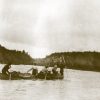Interview: SubArctic River Adventure 2012

July 14. Crew at JB Tyrell’s cairn on Carey Lake, Dubawnt River. From left: Lisa Goodman, Iva Kinclova, Brian Johnston, Rob Jordan (on boulder), Lee Sessions, Jim Gallagher. Photo by Lee Sessions.
In the summer of 2012, Canoeing.com contributor Brian Johnston headed to the far north with a crew of eight paddlers to explore a little-traveled region near the Ferguson River. They linked together several traditional routes, paddling parts of the Thelon, Dubawnt, Kazan, Ferguson and Wilson Rivers. They ended on Hudson Bay at Whale Cove, traveling a total of six rivers, six big lakes, covering over 600 miles of canoeing and 12 miles of portages to cross between watersheds. With triple portaging, that amounted to 60 miles of walking. They also pulled off a crew change at the trips mid-point. This fall, Canoeing.com caught up with two crew members— Johnston and Lee Sessions—to learn more about their trip. Read the Feature Story outlining their progress HERE >
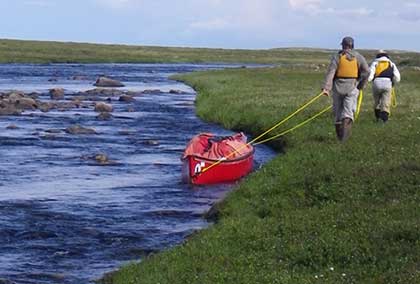
July 7. Lee and Lisa tracking upstream out of Jim Lake. Photo by Brian Johnson.
Canoeing.com: Tell us about your unique route.
Johnston: It was very unique going eastward when the rivers flowed north. One of my goals was to get into Ferguson system because no one paddles those rivers. But there are few float planes, so one way to get there was to portage. We went in with a good route plane—Jim had done a lot of [mapping] work with Google Earth, but what looks good on Google earth doesn’t always look so good when you get there.
The height of land crossings were very bushy, and it was not the best walking. We weren’t naïve going into it, but there were certainly places where Google Earth said there was a good creek, but then we got there and there was more rock than water. It was faster to hump across the land than paddle. It worked out that we did six miles of portages the first half, and another six miles on the second part, so 12 miles out of 600. We were triple portaging so that’s like walking 60 miles, or 10 percent of the distance we paddled.
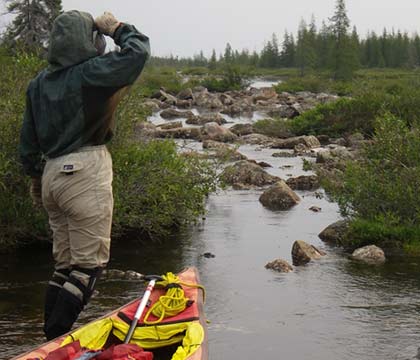
July 11. Iva pauses to contemplate the upstream and overland route to Carey Lake. Photo by Brian J.
Canoeing.com: How did the crew change go?
Sessions: The crew change was delayed due to bad weather. We had a great location for the plane but the wind shifted and we were stuck on an exposed shoreline. After a day being wind bound, we loaded up the canoes and paddled around the corner to another place where the plane could come in. We measured the depth with our paddles and it was plenty deep, but the pilot chose not to come to shore so we had to paddle out and unload the plane in the water.
Johnston: The pilot was taxing forward into the wind and then drifting back. It took an hour to unload everything, and it was windy so the 200-yard paddle out to the plane and back was between a 10 and 15 minutes paddle.
With people and going and coming it was a tough situation because the pilot was in charge because it was his plane, and we weren’t in a position to be overly in charge. None of us could stay by the plane because he kept moving it… Bottom line, it was awkward. But that’s the nature of the north.
Canoeing.com: One food pack was left behind at Kasba Lake during the crew change, you were already about 50 miles behind. How did that affect the trip?
Sessions: We had finalized all the food packing for the entire trip in June, and before we left home, we emailed an inventory list and photos of the packs to the two guys flying in for the second half. All of these packs were shipped in advance to Kasba Lake Lodge, and our contacts at home confirmed the delivery for us. All had arrived in Kasba. We used Cooke Custom Sewing food packs, bright red in color, and they were numbered in big letters, from one to six, and clearly labeled. As the plane flew off after the crew change, I counted packs and noted that there was no food pack with a #4 on it. Brian J made a satellite phone to call Kasba and they said one pack had been left behind in one of the cabins. Somehow the crew members flying in managed to carry all of the other packs down to the dock and load them on the plane, but in their excitement, did not count the total number of packs or note that one was missing. We were surprised that they had not noticed the missing pack, but we definitely needed the food it contained. The guys at Kasba said they had a re-supply flight heading to a nearby camp so they agreed to fly the food pack out to us the next day for a nominal cost instead of the full charter cost. They [had it to us the next day].
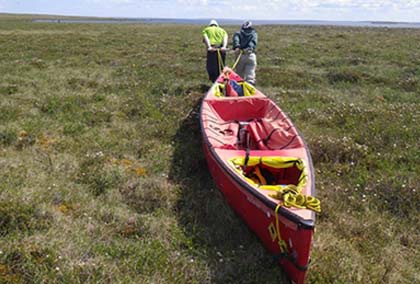
July 8. Jim and Iva dragging a canoe to Sid Lake. Photo by Brian J.
Canoeing.com: It sounds like the crew had a real range of paddling experience, and far north paddling in particular. Did that affect the trip?
Sessions: We had two people on the first part of the trip for whom it was their first Far North trip. It was great to hear their perspective about the trip, to gain insight into their point of view seeing the tundra for the first time. There was a bit of “orientation” involved to bring them up to speed, but nothing too extra-ordinary. It always takes some time to turn on your “trail mojo” at the beginning of the trip. They were good sports and took it all in stride.
The new additions to our crew brought unique perspectives and helped to round out the experience for everyone. For example, Rob was continually amazed at the remoteness and the vastness of the area we traveled through, and frequently commented on how rare it is to get totally “off the grid” and go where few humans have traveled.
The rest of the crew all had extensive far north paddling experience and that definitely made things easier. Four of us did the whole trip, but it would not have been possible without the folks who did either the first or second half of the trip. We determined early on that we did not want to carry more than 28 days of food with us. As we put together the crew, we found folks with similar motivations and sufficient experience to join for the required days.
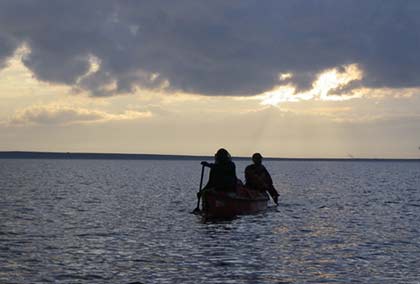
July 19. The group tries to make up time on Nowleye Lake by paddling late into the evening. Photo by Brian J.
Canoeing.com: How were group dynamics?
Sessions: We had some challenges amongst the team members…grousing about whether or not to paddle a particular stretch, when to stop for breaks or what constituted a good camp site…
This year, we tried something new and designated a person to be our trip leader. As usual, we paid a lot of attention to group process, allowing time for everyone to express their opinions. With several new people, it was important for them to be heard and often the crew leader or another member would try to summarize the various points of view and recommend a decision…
These are pretty minor issues in the grand scheme of things. Everyone tried to be flexible and understanding. The most important things for planning and organizing a trip like this are decided well before the trip: The planned route, how far to travel each day, what food and gear to bring. With most of us having extensive experience on our own trips and on trips together, we had a core common set of objectives, and we also understood the needs of others, so we could support individual goals such as time to fish or fly a kite, as well as our overall group goal of reaching our destination safely and on time while still enjoying our time together on the tundra.
Canoeing.com: Did you see other people?
Johnston: We saw two Norwegians on day two. They flew in over us and they were going right down the Thelon to Baker Lake, and then on the Ferguson system we passed a small lodge with a couple little cabins and it was being rented out by the lodge. People had contracted to do work for mining, drilling core samples so we stopped in there and said hi. And on Wilson on the last day we saw a guide come out to find his fishing net and at last rapid there were a couple people there, too.

July 20. A cold wind swept Nowleye Lake and postpones our crew change flight. Photo by Brian J.
Canoeing.com: How was the weather on this trip?
Sessions: We had some really extreme hot weather on the first part of the trip, which coincided with some of the most challenging portages we had to make. Later on, we lucked out with cooler days and a light breeze: perfect for portaging. We also had some really windy days throughout the trip and there were times when travel wasn’t possible or wasn’t worth the effort. We did have a few days of rain. Surprisingly, the weather in August was much better than the weather in July.
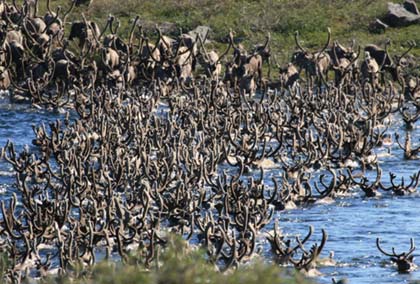
July 23. Thousand of caribou swam across a small bay on the north side of Angikuni Lake and milled around for a few hours. We sat and took photos from the ground and also with a Go Pro camera mounted on a kite. Photo by Lee S.
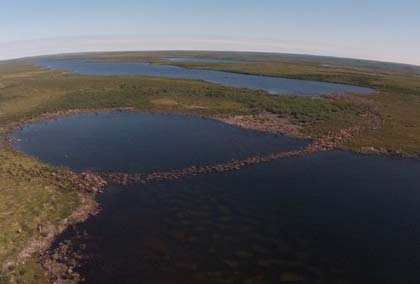
July 23. Caribou, Angikuni Lake. Rich Durant of Portland Oregon outfitted our crew with a Kite Aerial Photo (KAP) rig, a rotating bracket to attach to a kite. This enabled some amazing overhead shots including this herd of caribou. Kite photo by Lee S.
Canoeing.com: How was the wildlife?
Sessions: Wildlife was really amazing! We saw thousands of caribou, hundreds of muskox, and countless birds. It was hard to see wildlife on the first part of the trip, as we were going over the height of land, in and out of trees. We saw a few moose. But once we got out into the tundra again, caribou became plentiful. We found one huge herd milling about, rotating in a large circle. We watched them for hours… Then they decided to swim across the bay directly to us.
We found numerous herds of muskox loitering around, grazing and sleeping and playing. I set out in the direction of one herd, hoping to get some photos, and found myself five feet away from a big bull who was chewing a cud and looking the other direction. We were separated by a large willow bush. I sat down and waited for him to move. He sauntered off away from me.
On June 27, we set up the CCS tundra tarp at lunch, just as a big cloudburst hit. While we were huddled out of the wind eating our cheese and crackers and heating up soup and tea, Brian A asked us if any of us had ever seen a Wolverine. We were in the process of answering that question when one loped up from the willows on the hill just in front of us. It was an amazing site! We scrambled for our cameras but it quietly hobbled over the ridge into the rain.
Johnston: We saw fair bit of muskox herds [numbering] in the 20s. It’s easier to sit and watch several thousand caribou, but muskox are a little more spooky. We were sitting one night, just two of us, watching a herd and the herd changed direction and came running toward us. We said, “Don’t move, they’ll run right by.” Those are the moments you cherish and you don’t take a picture because a picture just doesn’t do it justice.

July 26. In the early morning, before a breakfast feed of fresh fish, Mel prepares mocha. Photo by Brian J.
Canoeing.com: What was it like to paddle Hudson Bay and arrive in Whale Cove?
Sessions: Paddling on the ocean was a highlight. One evening we gathered mussels while we waited for the tide to come in so we could paddle. Paddling through kelp beds was really cool. On our final day, we got up at 4AM and paddled 20 miles down Wilson Bay to the Hamlet of Whale Cove. As we pulled up on the beach, we were welcomed by Percy Kabloona, the Mayor of Whale Cove, and Brock Junkins, the Sr Civil Administrator, along with a few dozen residents. They saw us paddling for several hours and all convened on the shore when we made land. We were welcomed to the community. Very few paddlers come to Whale Cove, and we felt very lucky to be among them.
Canoeing.com: Any last thoughts?
Johnston: It’s not every day that you get to spend 50 days on a river in the far north, and for big trips you’re limited in a way. A lot of big rivers are more like a month long, so for big trips there’s an opportunity to do something a little more unique.
There’s also an intimacy of small rivers, and so it’s always nice when you’re connecting stuff because you’re in small watersheds. Big rivers get so big and overpowering and you feel so small and out of control. You’re paddling along and the shoreline is half a mile away, the land a quarter inch out of water and it rises so slowly you can’t see anything other than this black line. So it’s more intimate to be on smaller rivers systems, you just have to be willing to do the work.
When you get into the northern routine, to me it never gets old. I like the simple kind of life, and I like the motion aspect of moving across the land and then water, and the canoe is just a vessel in the north to see the land because in general it’s easy to paddle.
In the old days the Inuit would have walked a lot, that was their primary means of travel, but they would walk for months to get places. It’s hard for us to get away for months so the canoe is a faster way to cover a bit of ground.
Thinking about planning your own Far North trip? Read the Canoeing.com Far North Guide, by Brian Johnston.
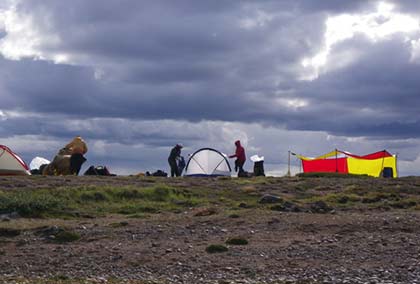
July 28. On Yathkyed Lake, the crew goes about setting up camp under an ominous sky. Photo by Brian J.


